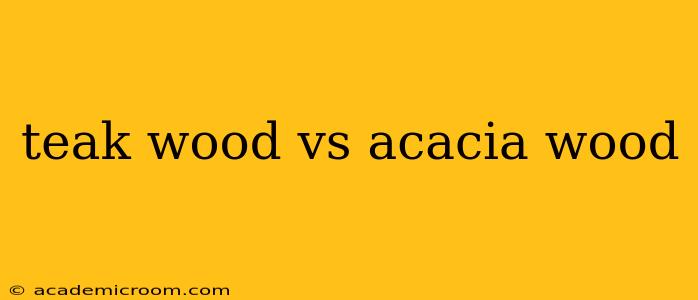Choosing the right wood for your furniture, decking, or other projects can be a daunting task. Two popular choices often top the list: teak and acacia. Both are known for their durability and attractive aesthetics, but they possess distinct characteristics that make them better suited for different applications. This comprehensive guide will delve into the key differences between teak wood and acacia wood, helping you make an informed decision.
What is Teak Wood?
Teak ( Tectona grandis) is a tropical hardwood prized for its exceptional durability, water resistance, and rich golden-brown color. Native to Southeast Asia, teak trees grow slowly, resulting in dense, strong wood with a naturally high oil content. This oil content contributes significantly to its resistance to rot, decay, and insect infestation. Over time, teak develops a beautiful silvery-gray patina, adding to its unique charm.
What is Acacia Wood?
Acacia (Acacia) is a broad genus of hardwood trees encompassing numerous species, with variations in color, grain, and density. While some acacia species are quite hard and durable, others are softer and less resistant to the elements. Acacia wood is generally more affordable than teak, often displaying a variety of colors ranging from light tan to dark reddish-brown. The grain patterns can also vary significantly depending on the specific acacia species.
Teak Wood vs. Acacia Wood: Key Differences
Here's a head-to-head comparison of teak and acacia across several crucial factors:
Durability and Longevity
Teak: Renowned for its exceptional durability and longevity. Its high oil and silica content make it highly resistant to rot, decay, insects, and weathering. Teak furniture and decking can last for decades with proper maintenance.
Acacia: Durability varies significantly depending on the species. Some acacia species are remarkably durable, while others are more susceptible to damage from moisture and insects. Generally, acacia is less durable than teak in outdoor applications.
Water Resistance
Teak: Naturally highly water-resistant due to its high oil content. It's an excellent choice for outdoor furniture, decking, and boat building.
Acacia: Water resistance is lower than teak, making it less suitable for prolonged exposure to moisture without proper treatment. While some acacia species offer decent water resistance, it's generally not as reliable as teak.
Maintenance
Teak: Requires minimal maintenance, especially when left to weather naturally. A simple cleaning is often sufficient. Periodic oiling can enhance its color and protect it from the elements.
Acacia: May require more frequent maintenance, especially in outdoor settings. It may benefit from regular sealing or oiling to protect it from moisture and UV damage.
Cost
Teak: Generally more expensive than acacia due to its slower growth rate, higher demand, and superior properties.
Acacia: More affordable than teak, making it a budget-friendly option for many projects.
Appearance
Teak: Possesses a distinctive, rich golden-brown color that weathers to a beautiful silvery-gray patina. The grain is typically straight and even.
Acacia: Displays a wider range of colors, from light tan to dark reddish-brown, with varying grain patterns.
Uses
Teak: Ideal for outdoor furniture, decking, boat building, flooring, and high-end interior applications.
Acacia: Suitable for indoor furniture, less demanding outdoor applications (with proper treatment), flooring, and some outdoor projects in drier climates.
Is Acacia Wood as Good as Teak?
No, acacia is generally not considered as good as teak, especially for outdoor applications requiring high durability and resistance to the elements. While some acacia species offer decent performance, teak's superior properties in terms of longevity, water resistance, and insect resistance make it the preferred choice for demanding environments.
What is the Most Durable Wood?
Several woods are known for exceptional durability, including teak, Ipe, and Cumaru. The "most durable" wood depends on the specific application and environmental conditions.
Which Wood is Better for Outdoor Furniture?
For outdoor furniture, teak is generally the superior choice due to its unmatched resistance to weathering and decay. However, properly treated acacia can be suitable for less demanding outdoor environments.
How to Tell the Difference Between Teak and Acacia?
Differentiating teak and acacia requires careful examination. Teak typically has a more uniform, straight grain and a richer, more golden-brown color that deepens with age. Acacia exhibits more color variation and often has a more pronounced grain pattern. A professional can usually identify the wood species through careful inspection.
In conclusion, both teak and acacia offer attractive qualities for various woodworking projects. However, teak's superior durability, water resistance, and longevity make it the premium choice for demanding outdoor applications. Acacia, while more affordable, requires careful consideration of its specific properties and potential limitations for longevity in outdoor use. Ultimately, the best choice depends on your budget, project requirements, and desired aesthetic.
